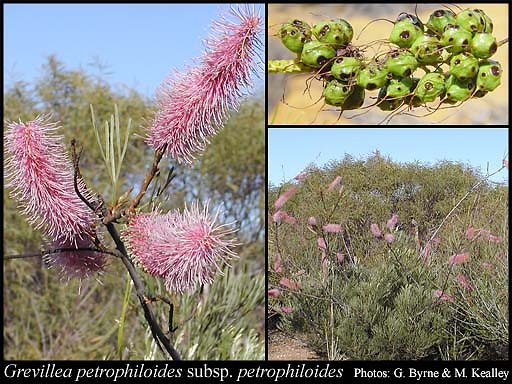- Conservation Code
- Not threatened
- Naturalised Status
- Native to Western Australia
- Name Status
- Current
Shrub (with emergent flowering branches), to 3 m high. Fl. pink-red/cream-white, Jan to Dec (peak Aug-Sep). Sand or gravel, laterite, ironstone. Sandplains, hill slopes and summits, road verges.

Scientific Description
Shrubs, 2.5-3 m high; branchlets glabrous or hairy, not glaucous. Leaves alternate, 50-130 mm long, hairy, on the abaxial surface, the hairs straight; lamina flat, once divided, pinnately divided, divided to the midrib; lobes 20-60 mm long, 0.5-2 mm wide, the margins revolute, enclosing the lower surface of the leaf blade, forming a groove either side of the midvein. Inflorescences axillary or terminal, red or pink; pedicels 1-3 mm long. Perianth 8-10 mm long; tepals some joined and some free after flower opens, glabrous; ovary hairy or glabrous, stipitate, the stipe 1-2 mm long; pistil 14-18 mm long, white, red or pink, pollen presenter conical, style hairy or glabrous. Follicles glabrous or glandular hairy, viscid, dehiscent, 7-9 mm long. Flowers in January, February, March, April, May, June, July, August, September, October, November or December. Occurs in the Eremaean (ER) or South-west (SW) Botanical Province(s), in the Carnarvon (CAR), Geraldton Sandplains (GS), Avon Wheatbelt (AW) or Mallee (MAL) IBRA subregion(s).
Distribution
- IBRA Regions
- Avon Wheatbelt, Geraldton Sandplains, Mallee.
- IBRA Subregions
- Geraldton Hills, Katanning, Lesueur Sandplain, Merredin, Western Mallee.
- Local Government Areas (LGAs)
- Bruce Rock, Chapman Valley, Coorow, Cunderdin, Dalwallinu, Dowerin, Goomalling, Greater Geraldton, Kellerberrin, Kondinin, Koorda, Merredin, Mingenew, Moora, Morawa, Mount Marshall, Narembeen, Northampton, Nungarin, Perenjori, Quairading, Tammin, Three Springs, Trayning, Victoria Plains, Westonia, Wongan-Ballidu, Wyalkatchem.